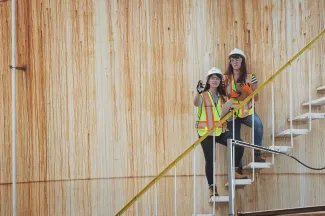"The building envelope plays a large role in the comfort and health of building occupants, and knowing that the decisions we make are contributing to the well-being of people is very rewarding."

Sameer Hasham
- Degree:
- Bachelor of Applied Science
- Grad year: 2009
- Program:
- Campus: Vancouver
Job: Associate, RJC Engineers
Tell us about your journey to engineering.
After graduating from high school, I did a year in computer science at the University of Ottawa. I quickly realized it wasn’t the right field for me and ended up back in Vancouver where I completed a university transfer program at Douglas College.
I then transferred to UBC where I began my studies in second-year civil engineering. Within a week of starting my engineering courses at UBC, I knew this was where I belonged.

My co-op experiences were also important in helping me determine my path. I initially thought I was interested in pursuing structural engineering, but while completing a co-op term at RJC, where I got to work on building envelope systems, I found a practice area that proved to be very exciting to me. It’s where I’ve worked ever since!
Civil Engineering Applied Science Co-op Program Transfer Programs
What do you like most about your job?
The variety of work is a lot of fun – it’s fascinating to be working on many different types of projects where there is no “one” solution. The outcomes of this work are also meaningful.
The building envelope plays a large role in the comfort and health of building occupants, and knowing that the decisions we make are contributing to the well-being of people is very rewarding.
It’s also exciting to be building structures with low carbon footprints. The built environment has a very large impact on energy and conservation, and the decisions we make about building envelopes and other engineering systems can make a positive difference in this area.









